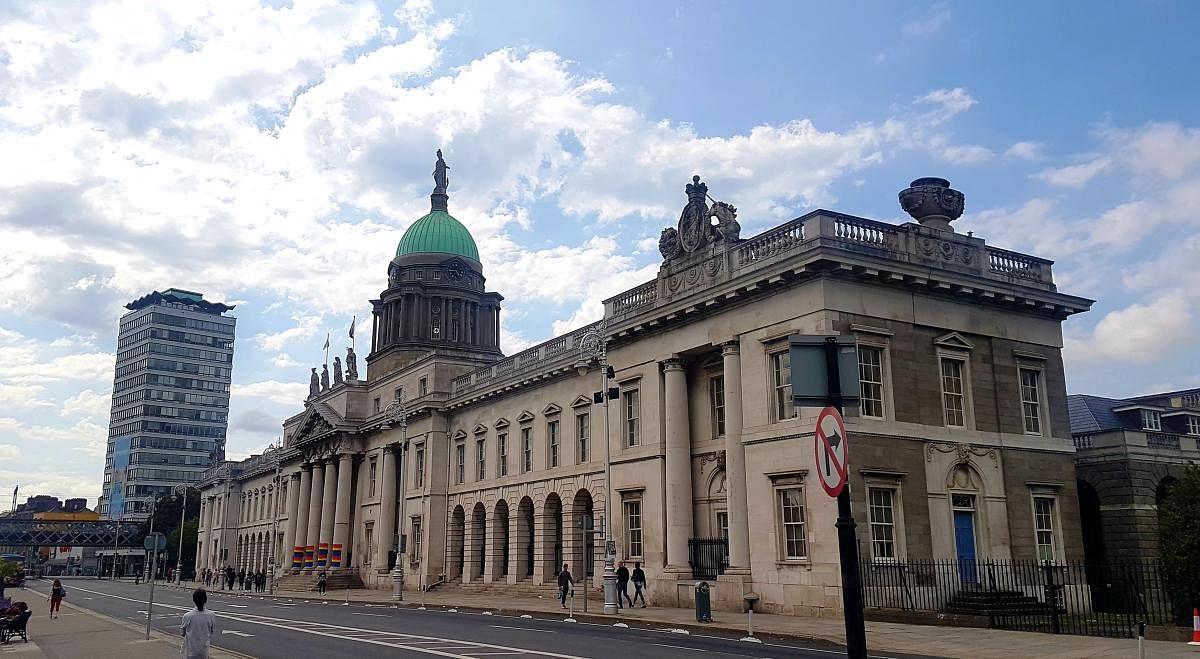

It’s a cloudy afternoon in Dublin when I meet my guide Julian Vignoles to explore the architectural skyline of the city. We walk through St Stephens Green, a prominent park of Dublin to reach Merrion Square that is the most prestigious Georgian square of the city. It is home to embassies, the arts council and various fashion houses. Merrion Square is also famous because it has the houses of William Butler Yeats, the Irish Noble laureate and poet and Oscar Wilde, the Irish poet and playwright. Yeats lived here for six years and during this time, he composed some of his meaningful poetry including the popular Sailing to Byzantium.
We head to Merrion Square park prominently located in the square to see the memorial sculpture of Oscar Wilde. Designed by Danny Osborne, jade procured from Canada forms Wilde’s green jacket while its collar is made of Thulite, a pink coloured gemstone. The sculpture’s head is made from jade got from Guatemala. Black granite forms his shoes. From the sculpture, across the main road, I can see his house at 1 Merrion Square. Throughout the square, we come across typical Georgian architecture characterised by 12 panelled windows and a brick front with four storeys over the basement. “If you look at the buildings, they have a top window which is small as that is where the servant quarters were located. The interiors of these buildings are elaborate and handcrafted by Italian craftsmen. The stairs are made of timber and the houses have high ceilings,” explains Vignoles as we reach Mount Street which is the longest untouched Georgian street between Ireland and UK with original 18th-century homes.
A more modern landscape of Dublin greets us at the Grand Canal Dock where the Grand Canal, one of the canals of Dublin has its harbour. This dock is now called silicon dock as it has the offices of Google, Facebook, Yahoo and Paypal. In the distance are the two iconic unused chimneys that are synonymous with Dublin. A little ahead, we stop at the office and studio of the music group U2. Housed inside an old warehouse at 18 Hanover Quay, the band recorded parts of four of their albums including Innocence and How to Dismantle an Atomic Bomb here. “We get to see The Edge, the band’s guitarist from time to time. A museum dedicated to U2 is in the pipeline,” adds Vignoles.
Another noteworthy feature at the dock is the diving bell which was used to clear the river bed by lowering it into the river bed. The water was removed using air pressure to enable the workers to climb down to build the port’s quay walls. The bell was used for almost a century up till 1958. It is now converted into a museum that contains pictures narrating the history of the bell. Along the trail are the multi-storeyed Dublin Convention centre with state-of-the-art facilities and the Samuel Beckett Bridge named after the Irish novelist Samuel Beckett. Santiago Calatrava, the well-known Spanish architect and engineer has designed this bridge that is shaped as a harp and is used for maritime traffic.
The Famine Monument in front of the International Financial Services Centre (IFSC) commemorates the people who passed away during the Great Famine in the mid 19th century. Almost a million people died and a million emigrated from the country due to the famine. This monument has been crafted by Rowan Gillespie, a sculpture from Dublin. We continue to walk till we come to the Custom House which took a decade to build. During the Irish War of Independence, it was reduced to ashes on May 25, 1921. Rebuilt, the building has the God of Commerce sculpted on its green dome. The God of Industry, the God of Plenty and Neptune representing the Sea are also sculpted on it. Custom House is one of the finest Georgian buildings and was the epicentre of trade as taxes were paid here.
As we continue on our architectural adventure, we reach Mount Joy Square which was the second square to be built in Dublin after Parnell Square. “It is inhabited by people from diverse non-Irish nationalities,” adds Vignoles.
By this time, we are nearing the end of our walk as we get to Parnell Square. It is built around Rotunda, a maternity hospital which is the oldest in the Republic of Ireland. Plans are afoot to give this square a cultural focus. We pass the writer’s centre where writers meet and share ideologies before visiting the writer’s museum which sheds light on the history of Irish writing.